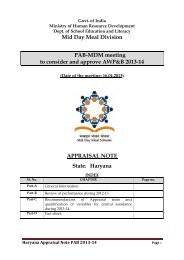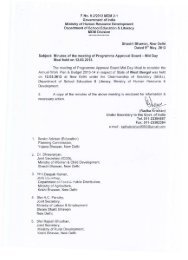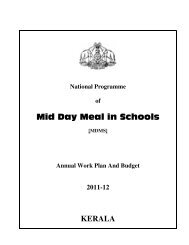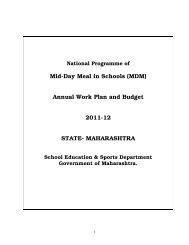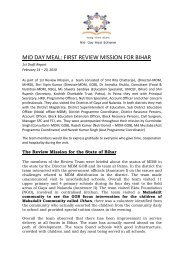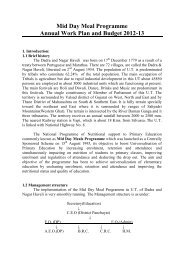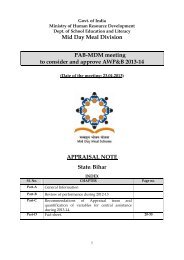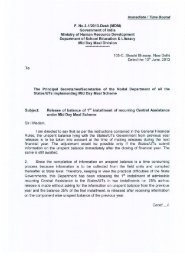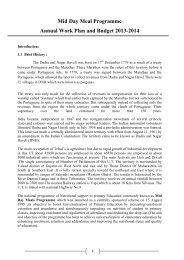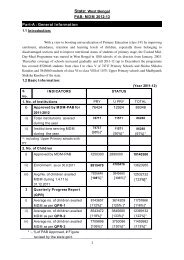Mid Day Meal Programme - Mid Day Meal Scheme
Mid Day Meal Programme - Mid Day Meal Scheme
Mid Day Meal Programme - Mid Day Meal Scheme
You also want an ePaper? Increase the reach of your titles
YUMPU automatically turns print PDFs into web optimized ePapers that Google loves.
about 6 per cent plastic plates and in about 6 per cent disposable plates.<br />
However for cooking foods mostly 60 per cent schools use aluminium pots<br />
and 37 per cent schools use iron pots respectively.<br />
Nutritional aspect, hygiene, good practice and management of hazards<br />
and wastage:<br />
With mid-day meal the maintenance of nutrition in foods is also attached. So<br />
imparting education on nutrition is one of the most important interventions.<br />
This study finds that in about 52 per cent schools nutrition education was<br />
imparted.<br />
About 89 per cent schools adhered to hygienic practices to be maintained to<br />
have MDM and out of this in about 8 per cent schools the cooks and helpers<br />
use caps, masks and gloves etc. In about 82 per cent schools vegetables are<br />
thoroughly washed before cutting. Also in about 86 per cent schools training<br />
on hygienic and cleanliness issues were provided<br />
Along with mid-day meal scheme the government also stressed on<br />
maintenance of certain good practices. It is found that about 88 per cent<br />
schools maintained cleanliness in dress, dish, hands and mouth. In about 86<br />
per cent schools inspection ofstudents’ nails have been conducted, in<br />
about 49 per cent schools prayer was said before meal. It is also<br />
observed that in 81 per cent schools team spirit and sharing situation exists<br />
and in 90 per cent schools discipline was maintained.<br />
Precautionary measures against hazards and wastages were directed by the<br />
government along with the MDMS. The study, in course of the study,<br />
observes that 50 per cent schools took measures against fire, another 50 per<br />
cent took measures against food poisoning, about 54 per cent schools<br />
took measures against food spoilage and about 56 per cent schools took<br />
measures against food wastage. In case of dirtiness 62 per cent<br />
schools took measures against it.<br />
Monitoring and transparency of the <strong>Scheme</strong><br />
The success of any continuous developmental programme depends on<br />
regular and effective monitoring. As per guidelines of the Directorate of<br />
Elementary Education the concerned officials from district down to block level<br />
officials have to conduct monitoring of the MDMS from time to time. As per<br />
norms every month 15 schools have to be monitored by DEEO, 20 schools by<br />
DI, 25 schools by BEEO and 40 schools by SI. This study finds that in the<br />
whole year of 2008 only 144 schools were monitored by DEEO, 81 schools by<br />
DI, 337 schools by BEEO and 545 schools by SI in all 18 selected districts. As<br />
the number of officials in each category are more it is significantly observed<br />
that the norms of monitoring suggested by the government have not been<br />
maintained.<br />
This scheme has scope for the community to participate in its better<br />
functioning. In this regard mother groups and School Managing<br />
Committees’(SMC) participation are significant. These two groups participated<br />
8



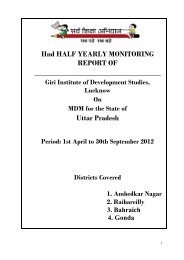
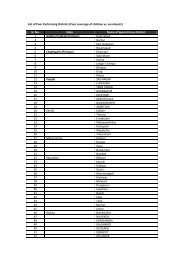
![Na National Programme Of Mid-Day-Meal in Schools [MDMS]tional ...](https://img.yumpu.com/51029020/1/184x260/na-national-programme-of-mid-day-meal-in-schools-mdmstional-.jpg?quality=85)


